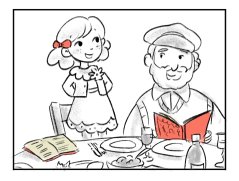
The Fir Kashes
“Far vos iz di dozike nakht fun peysekh andersh fun ale nekht fun a gants yor?” — “Why is this night of Passover different from all other nights of the year?” This question introduces the fir kashes (“four questions”), one of the best-known sections of the haggadah. Often recited by the youngest child at the seder, the fir kashes are asked as a way to begin telling the story of Passover.
The fir kashes set the tone for the “ask and reply” of the haggadah format beginning by asking why certain aspects of the seder night are different from all other nights of the year; and the rest of the haggadah provides the answers by telling the story of the Jews in Egypt and their miraculous exodus from slavery to redemption. The questions and their extended answers are a core aspect of the seder, fulfilling the Biblical obligation of telling the Passover story. Indeed, many seder participants expand on the traditional text as they read the haggadah aloud, asking more questions and offering new commentaries about this very different night.
As we hear in our movie, Libe chants the first of the fir kashes line by line in a sing-song intonation, starting in Hebrew and then continuing in Yiddish. In a traditional Yiddish-speaking milieu, a similar chanting and back-and-forth between Hebrew and Yiddish is used while studying Jewish texts. Children are introduced to this practice in kheyder with their very first encounter with the Torah: phrase by phrase, the original Hebrew is read aloud and then immediately translated into Yiddish. In this way, children learn Hebrew, and they continue to use this method of learning throughout their adult lives.
Below is one version of all fir kashes in Yiddish with English translation, as well as in the Hebrew of the haggadah. You can listen to a full recording of Libe singing the fir kashes here:
*Karpes (commonly spelled karpas) is a vegetable, often parsley or potato.
**In the Ashkenazi tradition kharoyses (charoset) is a mixture of chopped apples and nuts.
Additional Resources
If you are interested incorporating Yiddish in your seder, here are a few additional resources to explore:
- Passover songs sung by the Yiddish Philharmonic Chorus. Songs have subtitles with English translation and the Yiddish text in transliteration.
- In the Recorded Sound Archives of Florida Atlantic University, there are Yiddish Passover-related albums available to the public:
- Cindy Paley’s S’iz yontev, kinder! Lomir zingen! (It’s a Holiday, Children! Let’s Sing!) includes several Passover songs.
- Songs My Bubbe Should Have Taught Me - Volume 1: Passover by Lori Cahan-Simon is an entire album of Passover songs.
- Passover songs shared by folklorist Itsik Gottesman on his website, The Yiddish Song of the Week (presented by the An-sky Jewish Folklore Research Project):
A Note about the Song Khad-Gadyo
The song “Khad-Gadyo”, “One Goat”, is generally sung towards the end of the seder. According to a widely-accepted theory from historian Khone Shmeruk, the Aramaic version commonly sung today and which can be found in printed haggadahs is actually a translation of a Yiddish version once more commonly sung! Why then the translation? Aramaic, the language of the famed book of Jewish mysticism the Zohar, perhaps lent the song a more mystical feeling, and additionally made it more “fit to print” in the haggadahs, as Aramaic was considered a more distinguished and holy language than Yiddish.
